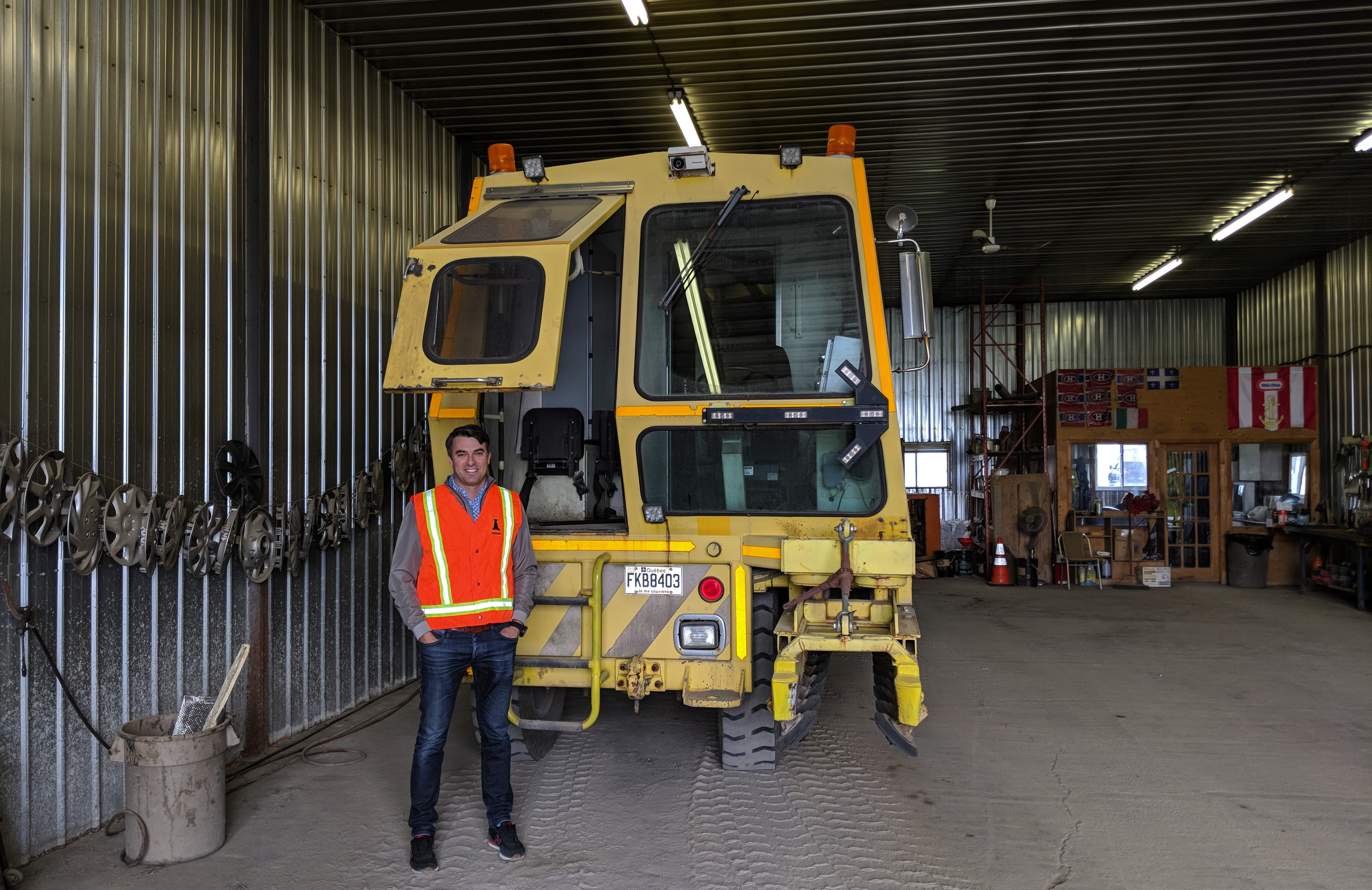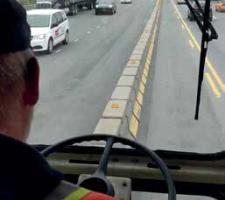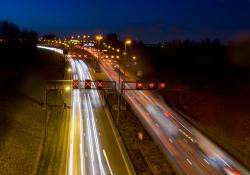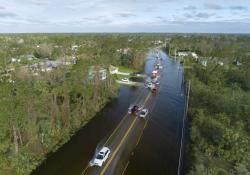
Greater vehicle connectivity is going to have huge implications for traffic management.
David Arminas climbed aboard a Lindsay Road Zipper to see what this might mean in future
As vice president of barrier specialist QMB Canada, Marc-Andre Seguin is sanguine about the future for moveable barriers.
On the one hand, it looks good. The oft-stated advantage of moveable barriers is that the systems are cheaper to install than adding a lane or two to a highway or bridge. Directional changes to lanes can boost volume on a road without disrupting travel times – usually reducing them, in fact – for road users.
QMB Canada, based in Laval, Quebec, is the Canadian distributor for the US-made
But on the other hand, the move towards autonomous, semi-autonomous and platooning vehicles could bring big changes to the design of roads including barriers, both fixed and moveable. These include crash strengths, barrier heights and overall dimensions. Are barrier manufacturers and purchasers of systems ready for the changes?
e
While the Zipper remains the ‘bread and butter’, Seguin says, for the company, QMB Canada distributes other barrier products, including crash cushions such as the Absorb 350, a narrow anchorless water-filled system, and the re-directive non-gating TAU II, also from Lindsay.
In addition, QMB makes the Barrier Guard 800, a portable steel barrier for temporary or permanent locations. Importantly, QMB Canada’s sister company Versilis - run by Seguin’s sister Marie-Claude – manufactures the SwiftGate system designed specifically for Zipper installations. The system consists of differing lengths of moveable gates that give early warning to drivers to leave the lane because an object or incident lies ahead – in this case the Road Zipper.
QMB Canada is looking at the possibility of having the Zipper used on the planned Gordie Howe International Bridge. The six-lane 2.5km cable-stayed structure is a Canadian public-private partnership project over the Detroit River to connect Detroit in the US state of Michigan and Windsor in the Canadian province of Ontario. If the Zipper is used, it will be the first time that the system has been part of a bridge design and not an add-on, says Seguin. It would be a major step forward for mobility in general and should be the way of the future.
But the 40-year-old mechanical engineering graduate is also a realist. Not many people – even within the road sector - fully appreciate how artificial intelligence and the advent of autonomous vehicles will change road design, as well as use.
Connected impact
Connectivity, he says, will change everything. However, removing the driver is probably going to be the least important factor in future road use and design. The major impact will be in how autonomous vehicles ‘talk’ to each other and learn from the behaviour of other AVs in an area through which all the connected vehicles are passing. Platooning of vehicles will have an incredible impact on road and bridge capacity, he believes.
If platooning autonomous vehicles drive at set distances to each other – closer than with a driver behind a wheel - then more cars can use the road. In practice, road and bridge capacities can be more accurately estimated and reached.
Two things arise from this. The assumption is that there will be fewer accidents. If there are fewer accidents, then standards for road safety furniture can change, perhaps be lowered if vehicle speeds are also lower. Even the need for moveable barriers may be reduced, making the market much more competitive for major players and less attractive for new entrants.
But these remain for now, only assumptions. What companies will start to sink money into developing newer barrier technologies to better the Zipper, he asks, if road designs and barrier needs could drastically change? “Also, do we really need to build more and larger bridges if we can be assured of using the current ones more efficiently thanks to connected vehicles?”
At what point will this happen or at least be more apparent than today and force a shift in thinking about infrastructure? He believes “much sooner than, say, 2040”, as some analysts suggest. It will be game-changing for all in the road design sector.
All aboard
The Zipper has to maintain an exact distance to the road surface to pick up the barrier and drop it down. The chassis can’t be allowed to float up and down, otherwise the elevated barrier could, as it passes under the Zipper, bottom out on the pavement.
This model is in operation for only about two to three hours a day, and normally for no longer than 45 minutes in any outing, explains Seguin.
Both ends are identical: “There is no front and no rear to a Zipper.” The driver in the forward position steers the Zipper to scoop up the barriers. The driver facing backwards at the rear steers to allow the Zipper to drop the barrier down in a straight line. Here lies the skill, he adds.
Each individual barrier section is 1m long and there is 15m of connected barrier sections inside the machine at any one time.
The rear-motion driver has to ensure a straight line and do so smoothly enough to not make it difficult for the forward-motion driver to steer the machine as it crawls forward to pick up the barrier. Above each driver is a small black and white video screen for a view of the road in front, or behind, of the other driver.
The vehicle appears to crab along as the barrier catcher on the forward end scoops up the barrier, lifting it off the pavement and depositing it to one side of its original position.
SwiftGate in action
The motion of the Zipper forces the slung barrier through a system that shifts it only to one side – not forward – and drops it down in a new position.
When the Zipper reaches the end of the barrier line, it reverses. In this way, what was the exit of the barrier is now the entrance as the Zipper travels back across the bridge, shifting the barrier again, to complete the lane change. The drivers’ jobs are now reversed.
When the Zipper approaches the end of the barrier line it must stop about 20m before the end. It doesn’t physically turn around. It simply drives off in the opposite direction.
However, first the crash truck which always follows behind will have moved out from behind the Zipper and headed down the road to the next interchange in order to come back in the opposite direction towards the Zipper. As it approaches the Zipper, a series of SwiftGates 35-50m apart move out from the median to warn and force drivers out of the lane closest to the median.
The SwiftGates let oncoming drivers know that the lane is being closed ahead and they will have to merge into the adjoining lane. The Zipper then safely moves off in the opposite direction, headed back to the shed and shifting the barrier the other half-lane width.
SwiftGate
SwiftGate is a remotely controlled system that can include two types of modules: gate and signage.
Gate modules consist of a pivoting gate, a solar panel and a control box. The high-density polyethylene gates are crash-tested to NCHRP TL-3 requirements and accepted by the FHWA (Federal Highway Administration) in the US.
Meanwhile, signage modules consist of a pivoting traffic sign, a solar panel and a control box. Both modules can be adapted with flashing lights and be installed on the right and/or the left side of the road.
Being solar-powered, each system is independent of any wiring for ease of installation. When activated, the system creates a continuous obstacle line that acts as a vehicle deterrent more effective than regular delineation like barrels and cones, according to Versilis. The SwiftGate remote monitoring control is operated via an RF unit, cellular phone or a web-based application.
The latest version of the system is fully operational on Montreal’s Highway 13. Before installation of SwiftGates, maintenance crew had to manually close the lane to traffic four times a day to accommodate the Zipper. Lane opening and closing is now done remotely off-site.













